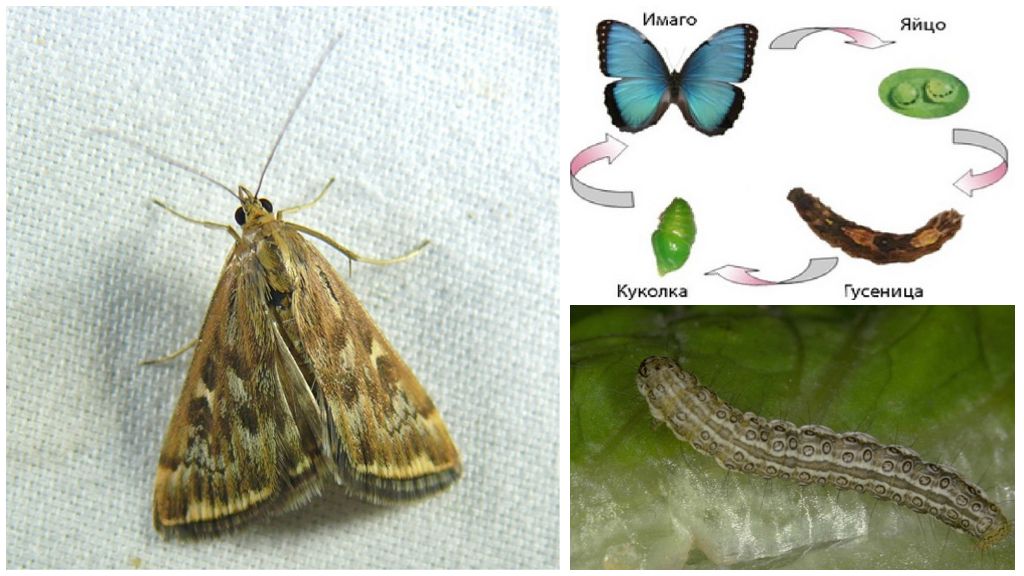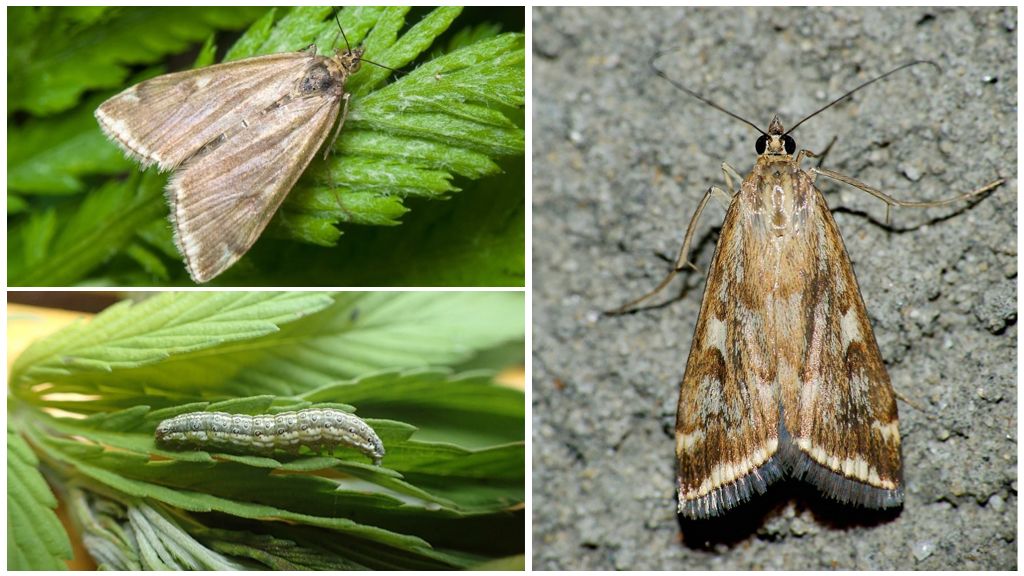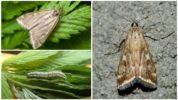- Life cycle
- Butterfly
The world of insects is very diverse, its representatives lead an active lifestyle not only during the day. Some species prefer night time, such a night lover is a moth. For most representatives, it is the dark time of day that is ideal.
Appearance
The insect moth belongs to the lepidopteran and stands on the same level as the butterflies. In scientific terminology, all small butterflies refer to moths. Externally, these two representatives of insects are very similar:
- Each of them has an elongated, spindle-shaped body. Only at the moth it is covered with a large number of hairs.
- There are necessarily two pairs of wings, the first pair is slightly better developed. Usually they have a protective color, dark colors prevail in moths.
- Three pairs of legs help to move the insect without the help of wings.
- On the round head are antennae, which have a thickening at the very beginning and are abundantly covered with hairs.
On a note!
The photo of moths shows that they are almost completely covered with hairs, through which they perceive the environment. They are especially sensitive on the antennae, the higher the hairiness, the better the butterfly is oriented in space.
Life cycle
The life of a moth does not differ in duration, a representative of the lepidopteran order can live from several weeks to 4 months, depending on the species.

Reproduction occurs after mating, since butterflies are heterosexual creatures. An individual goes through several stages of development, each of which is very different from the previous one.
- Larva. The female lays eggs most often directly on food. Often you can notice the egg laying on the back of the plants. In this state, the future moth is not long, very soon the larva will move to the next stage of development.
- Caterpillar. Their eggs appeared caterpillars cause the most harm, most of them absorb plants in huge quantities, thereby causing damage to agriculture.
- Dolly. Closer to autumn, the caterpillar wraps itself in a cocoon, in which it will winter. It is hibernation in this position that contributes to the wonderful transformation of the multi-legged caterpillar into a full butterfly.
- Imago In the early spring, as soon as the sun warms up, the cocoon begins to burst, a moth appears from it. He won’t be able to fly right away; his wings are very fragile and dry. After some time, the necessary amount of moisture will come to them, the butterfly will be able to fly up to continue its race.
Habitat
The distribution area is very extensive, moths feel great almost throughout the globe. They will not be able to grow and develop in cold climates. Temperature and high humidity for them are important indicators.
The most beautiful and largest representatives live in the tropics, there are specimens of huge sizes.
In our latitudes, there are also a lot of moths, most of them are considered pests.
Interesting!
The worst pest of the fields is the meadow moth; a high concentration of insects in the fields leads to a significant decrease in the yield of many crops. Take off with the use of drugs Bitobaxicillin, Fufanon, Karbofos. On household plots, caterpillars are collected manually, attracting natural enemies.
What are dangerous for humans
Adults feed exclusively on floral nectar, the same diet in large butterflies. Night moths do no harm to agricultural land, nor to humans. But the caterpillars eat herbaceous plants, which can adversely affect the quantity of the crop and its quality. That is why often farmers do not like butterflies of all sizes and colors.

The imago will not be able to harm the person, but some types of caterpillars secrete toxic substances, which, if they come into contact with the skin, can cause allergic reactions of varying complexity.
Important!
You should never touch the track with unprotected hands.
The most beautiful moths
In our latitudes, moths are inconspicuous; they have not an attractive color, but rather a protective one. A small black moth will not be able to attract attention, but there are other species.
- Venezuelan poodle. It was first described just recently, in 2009, so far it has not been possible to classify it. A distinctive feature is the hairiness of the butterfly, its hairs are longer and thicker than the rest of the lepidoptera.
- Saturnia moon. This species belongs to the largest moths, the wingspan of an adult is up to 12 cm. Lives in the forests of North America, prefers the east coast of the mainland.
- Peacock eyes. This species is recognized as one of the most beautiful and largest, the wingspan of a butterfly can reach 25 cm. The color is motley.
- Saturnia cecropium. Caterpillars feed exclusively on maple leaves, and the insect itself leads a nocturnal lifestyle. It differs from all others in large sizes, in the wingspan they open by 12 cm.
- Fingerfly. The strange shape of the body allowed this moth to get into the rating. The body structure resembles the letter T, the wings are thin, the butterfly itself looks fragile. A caterpillar of this species eats carnivorous sundews.
- Royal Nut Moth. Homeland is the south of North America, the wingspan is not very large, only 10 cm, but the fatness of the insect allows us to consider it one of the largest in the world. It is also called the red moth because of the specific color of the wings.
There are many moths on the globe, most of them are nocturnal. They do no harm, but their tracks can bring a lot of trouble.





